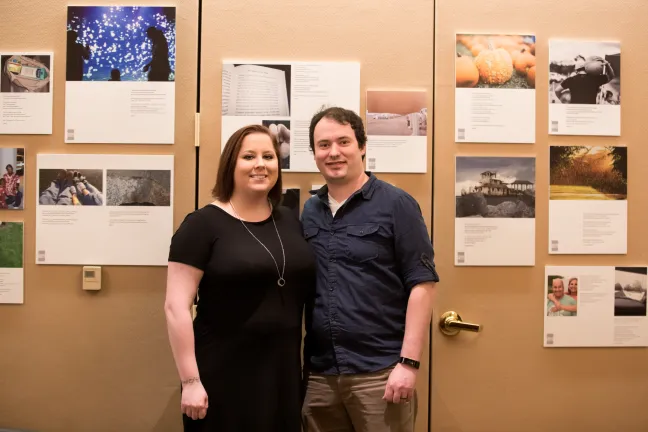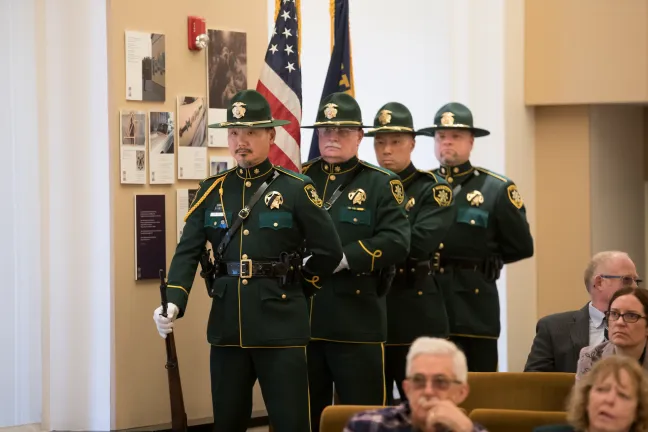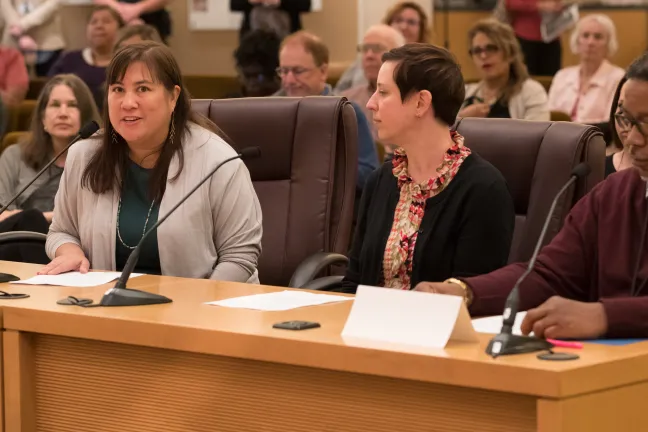On May 23, 2019 the Board of County Commissioners honored those who died in service during a proclamation recognizing Memorial Day in Multnomah County. The proclamation also featured an art exhibit chronicling the experience of veterans living with traumatic brain injury (TBI) and their caregivers.
The project, hosted by Multnomah County’s Aging, Disability and Veteran Services, the Veterans Task Force and the Veterans’ Health Administration’s Center to Improve Veteran Involvement in Care (CIVIC), paired participants with cameras. Through photos, the participants documented explored the impact of living with invisible injuries.
Here’s what the ceremony’s participants had to say, in their own words:
Traumatic Brain Injury: The Soldier
"I worked on the CH-47D, which is a model of Chinook helicopter. It’s a big one with two rotors on it. I have this memory of the smell of hydraulic fluid. So when I think of working on the Chinook, I think of being very dirty but also remember how slippery everything was. I loved working on the helicopters.
I was serving in Operation Iraqi Freedom. A dust storm had rolled in and I was trying to run out and cover the helicopter so dust wouldn’t get in the engine. So I was climbing on the back of the helicopter trying to put a big cover on it. We had been taking mortar fire but it had stopped for a minute. A mortar came in and landed close to me. Between the blast and the dust I fell off the back of the helicopter, about 30 feet. I landed flat on my back and my head bounced off the flight line.
They said, ‘We can’t put you in a flak jacket anymore. We can’t put you in a helmet anymore. We can’t even give you a weapon anymore.’ The only two things I wanted to do was work on helicopters or be a medic, and I couldn’t do any of those.
When I came back, I was really angry. There is a really strong sense in the military of “you just deal with it, shut up.” I spent so long saying ‘I’m fine, and I don’t need to deal with it’ before I really realized, ‘No, I’m not fine. And it’s okay to deal with it. And if I don’t deal with it now, you’re going to end up 50, never having dealt with it, and damaging all the relationships in your life.’”
I think this project helped me get into the psychology of my own TBI. I think I would probably be a couple steps behind in my therapy. This project really made me realize I’m still dealing with a lot of things. There are still things I need to address that I haven’t addressed yet."
Sawyer Sheldon, participant in the “From War to Home: Impact of Invisible Injuries.’’”
Traumatic Brain Injury: The Caregiver Husband
"My wife is a veteran. She served in Iraq for one tour. She worked on Chinook helicopters as the engineer. I met her in Kindergarten. We were kind of acquaintances and we became better friends in high school, but then she went away and served. It wasn’t until she returned until we started dating. She came back and her brain and her body weren’t quite the same.
I’m never sure how much I want to push. If she feels like telling a story, I let her tell a story. But she always tells me a story about, on her 21st birthday, drinking a non-alcoholic beer in a bunker as they were mortared and a copy of “Ob-La-Di, Ob-La-Da” by The Beatles keeps on repeating, and repeating, and repeating, and repeating for that entire time because it’s a different building and they can’t go and turn it off because they’re under attack.
We were at Mt. St. Helens and we were super excited. It was going to be awesome. But it was one of the first sunny days of the year, and there were tons of people there. Sawyer does not handle crowds well, and so we had to leave very very shortly after arriving. We were both really disappointed, and she was more disappointed in herself --that she can’t overcome this. It took away from what should have been a great experience. It’s not just a bunch of people to my wife. This was a threat: something to be feared.
A lot of times I become used to the situation, but having the camera was a way to remind myself to show everyone that people came back with damage, and my wife in particular came back with damage. It’s hard to express that in words and maybe taking these photos is a better way of explaining that."
Sean Gallagher, participant in the “From War to Home: Impact of Invisible Injuries.’’
Multnomah County Sheriff’s Office Honor Guard
"I always get nervous. I’ve been on Honor Guard for 11 years now. We’ve posted colors over 100 times. I always get a little bit nervous, but I think if I didn’t get nervous then we probably weren't doing something right or I didn't care enough. I think a lot of the Honor Guard members have that same feeling. It’s because of who you represent as a greater whole. That nervousness sets in because you want to do the absolute best you can every single time. It’s not something that we take lightly.
It’s important to us that we are dialed in, that we treat the honor and privilege of getting to carry our nation’s flag and present it in a formal manner, with the utmost respect it deserves. That’s why we practice and our uniforms look the way they look. We live in a great place and we have a lot of folks who have fought hard for that - a lot of families who have made sacrifices for that and some people who have even lost their lives for it."
Sgt. Bryan White, Multnomah County Sheriff’s Office
The program manager
"I spent a couple days installing the portraits and while I was unpacking them, I read them. I couldn't help but get drawn in. It’s really emotional and I think no matter what you did in service, we have similar stories or we hear similar stories in our work.
I was an officer in the U.S. Coast Guard. A lot of the people I served with are retiring now and doing their own disability claims and being confronted with the physical impacts of all that time in service.
I don’t know everyone suffering from traumatic brain injury knows that they have it. It’s so difficult to diagnose. Maybe we just need to have some patience and generosity with people with disabilities, and understand that they may not be experiencing the world the same more able-bodied people are.
As much as we may not realize it, our medical professionals want to cure invisible injuries as much as they can. They want to study it and find a solution. There is research going on, but it takes a while. It’s difficult to see when it’s going to be effective, but hopefully an exhibit like this shows there is an awareness — there’s just not a lot of knowledge yet."
Kim Douthit, Veterans Services Program Manager



